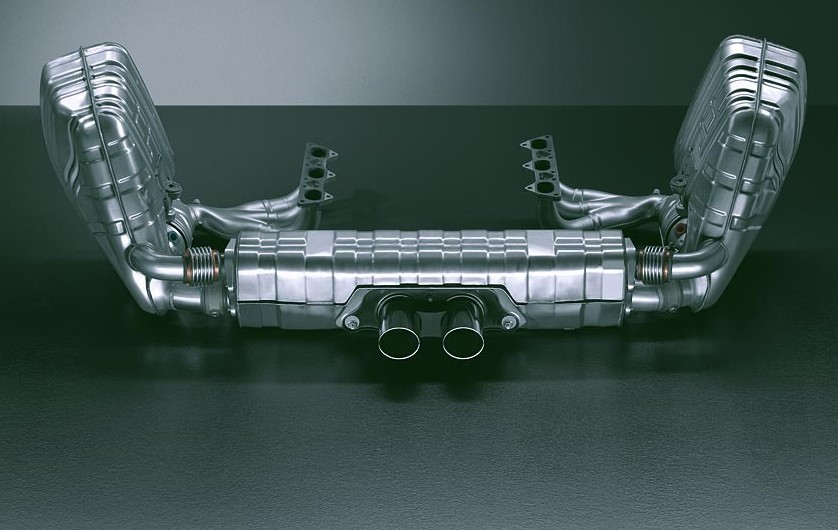Thought of the day: sounds of a silencer
Anyone who has stood next to a racing car being fired up will understand why the silencer was devised; petrol does not explode quietly and the effect on the eardrum at close quarters is painful. But the sound is part of the appeal of a sports car. We like to hear the engine working and that sound quality matters; a 747 simply roars overhead drowning conversation, but a Merlin V12 stops the conversation dead because those of us who appreciate things mechanical have to see what is creating this beautiful sound. So, progressively sports car silencers are being developed as sound-enhancing filters rather than mere barriers.
The Sport exhaust is one of the bestselling options on the water-cooled 911s. And with good reason; the soundtrack of a 911 has been one of its defining characteristics since the car’s inception. Classically, it combines induction roar, the cacophony of chain-driven camshafts and the bark of exhaust pipes in a symphony which is instantly recognisable. Increasingly, though, drive-by noise regulations meant that in its final air-cooled guise on the 993, the euphony of the M64 engine was a little muted, but still enough to please most aficionados.

However, in 1997 the new water-cooled engine, the M96, was of very different construction. Acoustically, the mechanical sounds of the engine were largely muffled by the water jacket. The 996’s soundtrack thus depended on the exhaust note and this was a disappointment. Porsche had erred on the conservative side in its quest to widen the appeal of the new 911. The standard 996 sounded, according to one well-known Porsche writer, ‘like a demented Dyson’ (I wonder who that was? – Ed). It must be said in Porsche’s defence that a decade ago all sports car manufacturers spent only a fraction of what they invest today on the black art of exhaust tuning.
Zuffenhausen soon rectified this state of affairs with the PSE, the Porsche Sport Exhaust. A button on the central console opened a valve in the exhaust creating a fruitier and deeper bass note. This was nicely conceived, especially as the 996 so-fitted bore no external signs; a triumphal blast could be indulged at the driver’s whim without giveaway badging, extra chrome or other visual exhibitionism.
So successful was this option that, with the 997 Porsche differentiated cars so-fitted with specific, larger-diameter exhaust tips. But then Weissach’s engineers fell into the trap of being a bit too clever. For a 997 fitted with the Sport Chrono, the PSE could only be brought into play by turning on the Sport Chrono Pack. This stiffened up the suspension and put the engine management into attack mode through a suddenly more sensitive accelerator pedal. For many owners, this was a perverse and irritating assumption that, just because the driver wanted the music louder, he was automatically going to drive much faster. Illogically, 997s without Sport Chrono could still have the individual on/off exhaust control.
The second-generation 997 posed an altogether bigger technical problem. This latest 997 has visually undergone only detail changes, but under the hood is a completely new engine. The A91 unit, besides reportedly having 40 per cent fewer individual parts, also has revised combustion in the form of direct fuel injection. In setting up the PSE Porsche’s engineers apparently had problems with sooty deposits around the exhaust tips (which would not seem to bode well for the life of the catalytic converter in a PSE system).
This is why the exhaust tips of the latest 911 have unsightly steel insets, said to defuse the visual effects of combustion better. There has been some dismay about this look and, no doubt, Porsche will devise a more elegant solution. Some owners have investigated retrofitting PSE on a non Sport Chrono car, thereby using the standard tailpipes. Porsche quotes three hours workshop time for the silencer work, but a further six hours if you want the electronic on/off switch. At least with cars factory-fitted with the option, PSE now has its own control again, operating independently of Sport Chrono.
Exhaust tweaking has advanced hugely in the last ten years and, by any yardstick, Porsche is surely one of the better exponents. The bass rumble of the current 911 gives way to a bark as the throttle is opened and culminates in that wail we know so well. To many people it is a much more mellifluous sound than the harsh, metallic rasp of the straight-six BMW. With loudness, Porsche has achieved the right balance between cars like the Maserati Quattroporte, which is too filtered (and thus encourages the driver to put his foot down a little too hard just to hear the engine) and certain Aston Martins. True, the Vanquish is stirringly vocal, but compared with the raw mechanical sound of, say, an early Lamborghini V12, where you can literally hear the engine singing down the pipes, the Aston soundtrack sounds like something that has been recorded on a compact disc and then over-amplified.
Granted, the effect of the PSE, like all these systems, is also contrived and no doubt the purist could find himself a bespoke pipe if he was determined enough. But for most owners in this decibel and emissions-regulated world, the Porsche item hits just about the right note.


Comments (0)